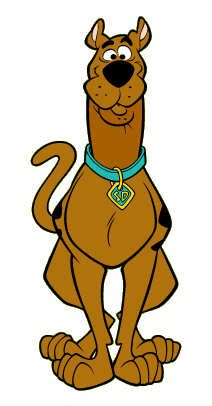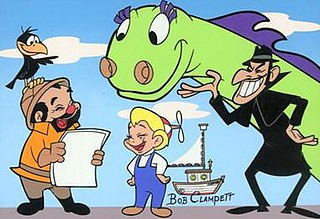Related Research Articles

Mighty Mouse is an American animated character created by the Terrytoons studio for 20th Century Fox. The character is a anthropomorphic superhero mouse, originally called Super Mouse, and made his debut in the 1942 short The Mouse of Tomorrow. The name was changed to Mighty Mouse in his eighth film, 1944's The Wreck of the Hesperus, and the character went on to star in 80 theatrical shorts, concluding in 1961 with Cat Alarm.

Terrytoons was an American animation studio in New Rochelle, New York, that produced animated cartoons for theatrical release from 1929 to 1973. Terrytoons was founded by Paul Terry, Frank Moser, and Joseph Coffman, and operated out of the "K" Building in downtown New Rochelle. The studio created many cartoon characters including Fanny Zilch, Mighty Mouse, Heckle and Jeckle, Gandy Goose, Sourpuss, Dinky Duck, Little Roquefort, the Terry Bears, Dimwit, and Luno; Terry's pre-existing character Farmer Al Falfa was also featured often in the series.

The Mighty Hercules is an animated television series based loosely on the Greek mythology character of Heracles, under his Roman name Hercules. It debuted on television in 1963. The show ran until 1966, coinciding with the sword-and-sandal genre of films popular between 1958 and 1965. Each stand-alone episode runs 5½ minutes, and in syndication was aired either as part of a block with other cartoons, or with several episodes airing consecutively to fill 30-minute time slots.
A deathtrap is a literary and dramatic plot device in which a villain who has captured the hero or another sympathetic character attempts to use an elaborate, improbable, and usually sadistic method of murdering them.

The Perils of Penelope Pitstop is an American animated television series produced by Hanna-Barbera Productions that premiered on CBS on September 13, 1969. The show ran for one season with a total of 17 half-hour episodes, the last first-run episode airing on January 17, 1970. Repeats aired on CBS until September 4, 1971; and in syndication as Fun World of Hanna-Barbera from 1976 to 1982. It is a spin-off of Wacky Races, reprising the characters of Penelope Pitstop and the Ant Hill Mob.

A crossover is the placement of two or more otherwise discrete fictional characters, settings, or universes into the context of a single story. They can arise from legal agreements between the relevant copyright holders, common corporate ownership or unofficial efforts by fans.

Scoobert "Scooby" Doo is the eponymous character and protagonist of the animated television franchise, created in 1969 by the American animation company Hanna-Barbera. He is a male Great Dane and lifelong companion of amateur detective Shaggy Rogers, with whom he shares many personality traits. He features a mix of both canine and human behaviors, and is treated by his friends more or less as an equal. Scooby often speaks in a rhotacized way, substituting the first letters of many words with the letter 'r'. His catchphrase is "Scooby-Dooby-Doo!"

Beany and Cecil is an American animated television series created by Bob Clampett for the American Broadcasting Company. The cartoon was based on the television puppet show Time for Beany, which Clampett produced for Paramount Pictures company and its Paramount Television Network beginning 1949. The series was broadcast first as part of the series Matty's Funnies during 1962, later renamed Beany and Cecil. A short-lived revival, The New Adventures of Beany and Cecil, was produced in 1988.

Mighty Mouse: The New Adventures is an American animated television series. It is a revival of the Mighty Mouse cartoon character. Produced by Bakshi-Hyde Ventures and Terrytoons, it aired on CBS on Saturday mornings from fall 1987 through the 1988–89 season. It was briefly rerun on Saturday mornings on Fox Kids in November and December 1992.

The Sylvester & Tweety Mysteries is an American animated television series produced by Warner Bros. Animation which aired from September 9, 1995 to February 5, 2000 on Kids' WB. The final episode, containing the segments "The Tail End?" and "This Is the End", was never shown on Kids' WB, not premiering until December 18, 2002, when the show aired in reruns on Cartoon Network. 52 episodes were produced.
The Mighty Heroes is an American Saturday morning animated television series created by Ralph Bakshi for the Terrytoons company. The original show debuted on CBS, on October 29, 1966, and ran for one season with 21 episodes.
The New Adventures of Mighty Mouse and Heckle & Jeckle is a 1979–1980 television series featuring newly produced Mighty Mouse and Heckle & Jeckle cartoons. The series was produced by Filmation, and aired from 1979 to 1980 on CBS with 96 episodes produced. It was the second Mighty Mouse cartoon series, following the original Mighty Mouse Playhouse from 1955 to 1967, and followed by Mighty Mouse: The New Adventures, which aired from 1987 to 1988.

The Mask: Animated Series is an American animated television series based on the 1994 film of the same title. The series ran for a total of three seasons and fifty-four episodes from August 12, 1995, to August 30, 1997. It spawned its own short-run comic book series, Adventures of The Mask. John Arcudi, former writer of the original comics, wrote two episodes of the series.
She Wronged Him Right is a 1934 Fleischer Studios animated short film starring Betty Boop. It marks the first appearance of Betty's semi-regular boyfriend, Fearless Fred.
No! No! A Thousand Times No!! is a 1935 Fleischer Studio animated short film, starring Betty Boop.
Lionel Wilson was an American voice actor, reader of audiobooks, stage actor, and author of children's books. He was known for his roles from Tom Terrific through to his last role, voicing Eustace Bagge on the Cartoon Network's Courage the Cowardly Dog.

The Perils of Pauline is a 1914 American melodrama film serial produced by William Randolph Hearst and released by the Eclectic film company, shown in bi-weekly installments, featuring Pearl White as the title character, an ambitious young heiress with an independent nature and a desire for adventure.

A serial film,film serial, movie serial, or chapter play, is a motion picture form popular during the first half of the 20th century, consisting of a series of short subjects exhibited in consecutive order at one theater, generally advancing weekly, until the series is completed. Usually, each serial involves a single set of characters, protagonistic and antagonistic, involved in a single story, which has been edited into chapters after the fashion of serial fiction and the episodes cannot be shown out of order or as a single or a random collection of short subjects.
StarBeam is a superhero animated streaming television series created for Netflix by Loris Lunsford and Jason Netter. The show follows Zoey, a young girl who is a superhero.
References
- ↑ "Paul Terry". Lambiek Comiclopedia. Retrieved 9 February 2020.
- 1 2 3 4 Hamonic, W. Gerald (2017). Terrytoons: The Story of Paul Terry and His Classic Cartoon Factory. John Libbey Publishing. pp. 150–151. ISBN 978-0861967292.
- ↑ Grant, John (2001). Masters of Animation. Watson-Guptill. p. 189. ISBN 978-0823030415 . Retrieved 9 February 2020.
- ↑ Pointer, Ray (2017). The Art and Inventions of Max Fleischer: American Animation Pioneer. McFarland & Co. p. 106. ISBN 978-1476663678 . Retrieved 9 February 2020.
- ↑ King Zilch on YouTube
- ↑ The Banker's Daughter on YouTube
- ↑ The Oil Can Mystery on YouTube
- ↑ Fanny in the Lion's Den on YouTube
- ↑ Hypnotic Eyes on YouTube
- ↑ Fanny's Wedding Day on YouTube
- ↑ Foiled Again on YouTube
- ↑ Lenburg, Jeff (1999). The Encyclopedia of Animated Cartoons. Checkmark Books. p. 114. ISBN 0-8160-3831-7 . Retrieved 6 June 2020.
- ↑ The Villain Still Pursued Her on YouTube
- ↑ The Saw Mill Mystery on YouTube
- ↑ "Restored Classic Animation". UCLA Film & Television Archive. Retrieved 10 February 2020.